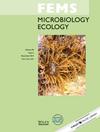Unbalanced predatory communities and a lack of microbial degraders characterize the microbiota of a highly sewage-polluted Eastern-Mediterranean stream
IF 3.5
3区 生物学
Q2 MICROBIOLOGY
引用次数: 0
Abstract
Wastewater pollution of water resources takes a heavy toll on humans and on the environment. In highly polluted water bodies, self-purification is impaired, as the capacity of the riverine microbes to regenerate the ecosystem is overwhelmed. To date, information on the composition, dynamics, and functions of the microbial communities in highly sewage-impacted rivers is limited in particular in arid and semi-arid environments. In this year-long study of the highly sewage-impacted Al-Nar/Kidron stream in the Barr al-Khalil/Judean Desert east of Jerusalem we show, using 16S and 18S rRNA gene-based community analysis and targeted QPCR, that both the bacterial and micro-eukaryotic communities, while abundant, exhibited low stability and diversity. Organic compounds hydrolyzers, and nitrogen and phosphorus recyclers were lacking, pointing at a reduced potential for regeneration. Furthermore, facultative bacterial predators were almost absent, and the obligate predators Bdellovibrio-and-like-organisms were found at very low abundance. Finally, the micro-eukaryotic predatory community differed from those of other freshwater environments. The lack of essential biochemical functions may explain the stream's inability to self-purify while the very low levels of bacterial predators and the disturbed assemblages of micro-eukaryote predators present in Al-Nar/Kidron may contribute to community instability and disfunction.东地中海一条受到严重污水污染的溪流微生物群落的特点是捕食性群落不平衡和缺乏微生物降解剂
水资源的废水污染对人类和环境都造成了严重危害。在受到严重污染的水体中,自净能力会受到损害,因为河流微生物再生生态系统的能力已不堪重负。迄今为止,有关受污水严重影响的河流中微生物群落的组成、动态和功能的信息非常有限,尤其是在干旱和半干旱环境中。在对耶路撒冷以东哈利勒巴尔/朱丹沙漠中受污水严重影响的 Al-Nar/Kidron 溪流进行的为期一年的研究中,我们利用基于 16S 和 18S rRNA 基因的群落分析和有针对性的 QPCR 显示,细菌和微真核细胞群落虽然数量丰富,但稳定性和多样性较低。有机化合物水解者、氮和磷回收者缺乏,这表明再生潜力降低。此外,几乎不存在兼性细菌捕食者,兼性捕食者 Bdellovibrio- 和类生物的数量也很低。最后,微真核细胞捕食群落与其他淡水环境中的捕食群落有所不同。缺乏必要的生化功能可能是溪流无法自净的原因,而 Al-Nar/Kidron 的细菌捕食者数量极少,微真核捕食者群落混乱,可能是造成群落不稳定和功能失调的原因。
本文章由计算机程序翻译,如有差异,请以英文原文为准。
求助全文
约1分钟内获得全文
求助全文
来源期刊

FEMS microbiology ecology
生物-微生物学
CiteScore
7.50
自引率
2.40%
发文量
132
审稿时长
3 months
期刊介绍:
FEMS Microbiology Ecology aims to ensure efficient publication of high-quality papers that are original and provide a significant contribution to the understanding of microbial ecology. The journal contains Research Articles and MiniReviews on fundamental aspects of the ecology of microorganisms in natural soil, aquatic and atmospheric habitats, including extreme environments, and in artificial or managed environments. Research papers on pure cultures and in the areas of plant pathology and medical, food or veterinary microbiology will be published where they provide valuable generic information on microbial ecology. Papers can deal with culturable and non-culturable forms of any type of microorganism: bacteria, archaea, filamentous fungi, yeasts, protozoa, cyanobacteria, algae or viruses. In addition, the journal will publish Perspectives, Current Opinion and Controversy Articles, Commentaries and Letters to the Editor on topical issues in microbial ecology.
- Application of ecological theory to microbial ecology
- Interactions and signalling between microorganisms and with plants and animals
- Interactions between microorganisms and their physicochemical enviornment
- Microbial aspects of biogeochemical cycles and processes
- Microbial community ecology
- Phylogenetic and functional diversity of microbial communities
- Evolutionary biology of microorganisms
 求助内容:
求助内容: 应助结果提醒方式:
应助结果提醒方式:


